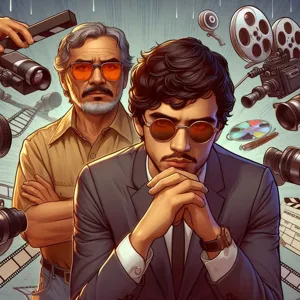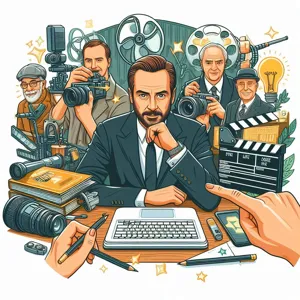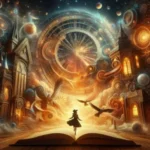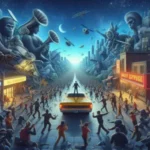Every great film begins with a spark of inspiration, a vision that transforms mere words on a page into a captivating visual narrative.
At the helm of this transformative journey is the director, the mastermind responsible for breathing life into the script and guiding the cast and crew through the intricate dance of storytelling. In this blog post, we delve into the director’s vision—the blend of artistry, intuition, and technical prowess that shapes the heart and soul of a film. From the initial concept to the final cut, we’ll explore how directors harness their unique perspectives to create compelling characters, evoke powerful emotions, and curate unforgettable cinematic experiences. Join us as we peel back the layers of filmmaking to uncover the essential elements that define a director’s creative process and the lasting impact of their vision on audiences around the world.
1. Understanding the Director’s Role in Filmmaking

The role of the director in filmmaking is both multifaceted and pivotal, acting as the creative compass that guides the entire project from inception to final cut. At the core, a director is responsible for translating a script into a visual narrative, infusing it with their unique artistic vision. This requires a deep understanding of storytelling, character development, and the emotional arcs that resonate with audiences.
Directors are often seen as the storytellers of the film, making critical decisions that shape the tone, pacing, and overall aesthetic. They collaborate closely with writers, cinematographers, production designers, and actors, ensuring that every element—from lighting to performances—aligns with their vision. This collaborative effort is akin to conducting an orchestra, where each department plays a vital role in creating a harmonious final piece.
Moreover, a director must possess strong leadership skills. They not only need to inspire and motivate their crew and cast but also navigate the complexities of a film set, which can include tight schedules, budget constraints, and unexpected challenges. The ability to communicate effectively, provide constructive feedback, and foster a creative environment is essential for bringing their ideas to life.
In summary, understanding the director’s role in filmmaking goes beyond just directing actors or blocking scenes; it encompasses a holistic approach to storytelling. A director is the heart and soul of the film, breathing life into the script and creating a vision that resonates long after the credits roll. Their passion and creativity are what ultimately turn a mere script into a compelling cinematic experience.
2. The Importance of a Clear Vision
In the world of filmmaking, a clear vision is the compass that guides every decision, from the casting of actors to the framing of each shot. It is the beating heart of the project, setting the tone, mood, and narrative direction. A well-defined vision not only informs the storyline but also influences the visual style and overall aesthetic of the film.
A director with a clear vision is able to articulate their ideas in a way that inspires the cast and crew, uniting everyone under a common goal. This shared understanding fosters a collaborative environment where creativity can flourish. When each member of the team—from the cinematographer to the production designer—understands the director’s vision, they can contribute in ways that enhance the storytelling, ensuring that every element works harmoniously to create a cohesive final product.
Moreover, a strong vision acts as a decision-making tool throughout the production process. In the chaotic environment of a film set, where time and resources are often limited, the director’s vision serves as a touchstone to evaluate choices and alterations. Whether it’s adapting to unforeseen challenges or choosing between multiple creative options, having a clear vision helps maintain focus and coherence, ensuring that the integrity of the story remains intact.
Ultimately, the importance of a clear vision cannot be overstated. It is the foundation upon which a film is built, infusing it with meaning and resonance. When audiences feel the heart and soul of a film, they connect with it on a deeper level, creating an experience that lingers long after the credits have rolled. A director who invests time and thought into cultivating a clear vision will not only enhance the quality of their film but also leave a lasting impact on their audience.
3. Developing a Concept: From Idea to Script

Developing a concept is one of the most exhilarating yet challenging phases in the filmmaking process. It is where raw ideas begin to take shape, transitioning from fleeting thoughts into a structured narrative that will ultimately become a film. This stage is crucial for a director, as it lays the groundwork for everything that follows.
The journey often starts with a simple spark—perhaps a powerful image, a compelling character, or a thought-provoking question. Directors may find inspiration from personal experiences, current events, literature, or even dreams. This initial concept serves as the heart of the film, encapsulating its central themes and emotional undercurrents.
Once the concept is defined, the next step is to develop it into a script. This involves a meticulous process of brainstorming, outlining, and drafting. Directors often collaborate closely with screenwriters, sharing their vision while remaining open to creative suggestions. This symbiotic relationship between director and writer is essential; the director’s insights can bring depth to the characters and plot, while the writer’s craftsmanship can transform abstract ideas into compelling dialogue and narrative structure.
As the script evolves, the director must consider various elements, including character arcs, pacing, and visual storytelling. What emotions do they want the audience to feel? How will the setting enhance the story? These are pivotal questions that guide the script’s development. The director may create mood boards or visual references to communicate their vision more effectively, ensuring that the script resonates with the intended emotional tone.
Moreover, this stage is also about refining and honing the script. It’s common for directors to go through multiple drafts, seeking feedback from trusted peers or mentors. Each revision is an opportunity to strengthen the narrative, clarify motivations, and eliminate any plot holes. The aim is to create a cohesive and engaging story that captivates audiences from beginning to end.
In essence, developing a concept is a transformative journey, where a mere idea blossoms into a fully realized script that serves as the blueprint for the film. This stage is not just about putting words on a page; it is about breathing life into a vision, setting the stage for the emotional and visual experiences that will unfold on screen. As the director meticulously crafts this foundation, they are not only shaping the film’s narrative but also inviting the audience into a world that is uniquely their own.
4. Crafting Characters: Building Emotional Depth
Crafting characters is one of the most critical aspects of filmmaking, as it is through these individuals that audiences form connections and engage with the story on a personal level. A well-developed character transcends the screen, resonating with viewers and evoking a spectrum of emotions that can linger long after the credits roll.
To build emotional depth, a director must delve into the intricate layers of each character, exploring their motivations, fears, and desires. This process often begins with thorough character sketches or backstories that provide context to their actions and decisions. For instance, a seemingly villainous character might have a tragic past that shapes their worldview, allowing audiences to empathize with them despite their flaws. By humanizing characters, directors create a bridge between the on-screen narrative and the viewer’s lived experiences.
Moreover, dialogue plays a pivotal role in character development. Authentic, well-crafted conversations can reveal vulnerabilities, wit, and depth, allowing actors to embody their roles fully. Directors should encourage actors to improvise or experiment with their lines, fostering an organic connection that enhances the emotional resonance of the scenes.
Visual storytelling also contributes to character depth. Through careful attention to body language, facial expressions, and even wardrobe choices, a director can subtly convey a character’s inner turmoil or growth. Consider the use of close-up shots to capture a fleeting moment of doubt or joy, allowing the audience to feel the weight of the character’s journey.
Ultimately, crafting characters involves a delicate balance of writing, performance, and visual storytelling. When executed thoughtfully, these elements coalesce to create a rich tapestry of emotional depth that captivates audiences, making them not just spectators, but active participants in the characters’ journeys. It is this connection that breathes life into a film, ensuring it resonates in the hearts and minds of viewers long after the final scene fades to black.
5. Visual Storytelling: The Power of Cinematography

Cinematography is often described as the visual language of a film, weaving together images, colors, and movements to convey emotions, themes, and narratives. It’s more than just capturing a scene; it’s about creating an immersive experience that resonates with the audience on a deeper level. The director’s vision is brought to life through the lens of the cinematographer, who transforms the script into a visual masterpiece.
Every choice made in cinematography—from the angles and lighting to the color palette and framing—contributes to the storytelling. A close-up shot can capture the raw vulnerability of a character, while a wide shot can establish the vastness of a landscape or the isolation of a figure within it. For example, consider how a dimly lit room can evoke feelings of tension and uncertainty, while bright, vibrant colors can instill a sense of joy and optimism.
The relationship between the director and the cinematographer is crucial; they must collaborate closely to ensure that every frame aligns with the director’s vision. Together, they explore creative techniques—such as camera movement, depth of field, and even lens selection—to enhance the emotional undertones of the film. A sweeping crane shot might symbolize freedom, while a shaky handheld camera can create an intimate, immediate connection with the viewer.
Furthermore, visual storytelling extends beyond camera work. The use of symbols, motifs, and visual metaphors can add layers of meaning, enriching the narrative. For example, a recurring image of a wilting flower may symbolize a character’s fading hopes or deteriorating relationships. These visual elements help to create a cohesive artistic vision that elevates the film from mere entertainment to an evocative exploration of the human experience.
In essence, cinematography is a powerful tool that molds the heart and soul of a film. It transforms the director’s vision into a sensory experience, guiding the audience through a world of emotion, story, and artistry. When executed with intention and creativity, it leaves an indelible mark that lingers long after the credits roll, inviting viewers to reflect on the journey they’ve just experienced.
6. Collaborating with the Creative Team
Collaboration is at the heart of every successful film, and a director’s ability to foster a creative environment can make all the difference in transforming a script into a cinematic masterpiece. This collaborative spirit begins with assembling a talented team, each member bringing their unique skills and perspectives to the table. From cinematographers and production designers to costume designers and editors, every creative voice contributes to the film’s overall vision.
A director must cultivate open lines of communication, encouraging team members to share their ideas and insights freely. This not only enhances the creative process but also instills a sense of ownership and pride among the team. Regular meetings and brainstorming sessions can spark innovative solutions to challenges that arise during production, while informal conversations can lead to game-changing ideas that elevate the film.
Moreover, collaboration goes beyond just the crew; it extends to the actors as well. A director should create a safe space for performers to explore their characters deeply. Encouraging improvisation and experimentation can reveal unexpected layers and nuances in performances, leading to more authentic portrayals that resonate with audiences. The director’s vision should serve as a guiding light, but flexibility and trust in the creative team’s capabilities can lead to magical moments that surpass initial expectations.
In this intricate dance of collaboration, the director must also be adept at balancing differing opinions and artistic visions. Navigating this terrain requires diplomacy and a clear understanding of the film’s goals. By harmonizing the various elements, a director can ensure that every aspect of the production aligns with the heart and soul of the film, ultimately creating a cohesive and compelling narrative that captivates viewers. In essence, the director’s vision is not just a solitary pursuit; it’s a collective journey that transforms a shared passion for storytelling into a remarkable cinematic experience.
7. The Role of Production Design in Realizing Vision

Production design is the backbone of a film’s visual storytelling, encompassing everything from the choice of colors and materials to the arrangement of space and props. A production designer works closely with the director to ensure that every element on screen aligns with the film’s overarching vision, creating a cohesive world that immerses the audience in the narrative.
Imagine a sprawling, post-apocalyptic landscape where every cracked wall and rusted vehicle tells a story of a world long lost. The production designer is responsible for sculpting this environment, carefully selecting textures and tones that reflect the emotional undercurrents of the film. By crafting detailed sets, choosing appropriate locations, and sourcing or creating unique props, the production designer adds depth and context to the story, transforming mere dialogue into a rich tapestry of visual cues.
Furthermore, production design extends beyond just the physical spaces on screen. It also encompasses the characters’ costumes, makeup, and even the lighting schemes that breathe life into the scenes. A well-designed environment can evoke specific emotions, enhance character development, and foreshadow plot twists. For instance, a vibrant, chaotic marketplace can suggest a bustling, lively community, while a stark, minimalist room may invoke feelings of isolation or tension.
Ultimately, the role of production design is to serve as a bridge between the director’s vision and the audience’s experience. By collaborating with cinematographers and art directors, production designers ensure that every frame is not only visually stunning but also rich with meaning. Through their meticulous attention to detail, they create a world that resonates with viewers, allowing them to fully engage with the film. In essence, production design is not just about decoration; it is the very heart and soul of a film, vital to bringing a director’s vision to life.
8. The Art of Directing Actors: Eliciting Authentic Performances
Directing actors is both an art and a science, a delicate dance that requires intuition, communication, and a deep understanding of human emotion. At the heart of a powerful film lies the performances of its actors; they breathe life into the script, transforming mere words into vivid characters that resonate with audiences. As a director, your role is to guide these talented individuals, helping them navigate the nuances of their roles while eliciting authentic performances that feel organic and true.
One of the most vital tools in a director’s arsenal is the ability to create a safe and collaborative environment on set. Actors must feel comfortable to explore their characters, to take risks, and to express vulnerability without fear of judgment. Establishing trust is paramount; this often involves open dialogue, where actors are encouraged to share their thoughts and interpretations of the character. By fostering a supportive atmosphere, directors can unlock the potential within each performer, allowing them to deliver nuanced and emotionally charged portrayals.
Moreover, understanding the unique process of each actor is essential. Some may prefer detailed character backstories and specific direction, while others thrive on spontaneity and improvisation. Adapting your approach to suit their style can yield extraordinary results. It’s about striking the right balance—providing enough guidance to keep the performance aligned with the film’s vision, while also allowing space for the actor’s individuality to shine through.
Additionally, a director must be adept at using various techniques to draw out genuine emotions. This can involve employing specific exercises that encourage actors to connect with their characters on a deeper level. Whether it’s through movement, vocal warm-ups, or even role-playing, these exercises can help break down barriers and lead to more authentic interactions on camera.
Ultimately, the art of directing actors is about crafting an experience that transcends the script. It’s about digging into the heart of the characters, understanding their motivations, and guiding the actors to embody these complexities fully. When done effectively, the result is a film that resonates deeply with audiences, leaving them captivated and emotionally invested in the story being told. In this intricate interplay between director and actors, the soul of the film is born.
9. Music and Sound Design: Enhancing Emotional Impact
Music and sound design are not just supplementary elements in filmmaking; they are the very heartbeat of a film’s emotional landscape. The right score can transform a mundane scene into a poignant moment, while carefully crafted sound design can elevate tension, create atmosphere, and immerse the audience in the story. As a director, harnessing the power of music and sound is essential for crafting a film that resonates deeply with viewers.
Consider the haunting melodies that linger long after the credits roll; they are often the result of a collaborative process between the director and a skilled composer. This partnership is pivotal, as the director’s vision must align with the composer’s interpretation of the film’s themes. From sweeping orchestral scores that evoke feelings of grandeur to minimalist piano compositions that underscore intimate moments, each musical choice should serve to enhance the narrative and deepen the emotional impact.
Sound design, on the other hand, is an art form in itself. It involves not only the musical score but also the intricate layering of ambient sounds, sound effects, and dialogue. A director must work closely with sound designers to ensure that every rustle of leaves, distant thunder, or heartbeat adds to the film’s immersive quality. The subtle crackle of footsteps on gravel can evoke a feeling of isolation, while the crescendo of a symphony can amplify a climactic moment, leaving the audience on the edge of their seats.
In this way, music and sound design work hand in hand to create a cohesive emotional experience. When a film’s music swells at just the right moment, it can elicit tears, laughter, or a sense of wonder, making the audience feel as though they are part of the story. A director who pays careful attention to these elements understands that they are not mere accessories; they are vital components that breathe life into the film’s heart and soul, ensuring that it lingers in the hearts of viewers long after they leave the theater.
10. Editing: Shaping the Final Narrative
Editing is where the magic truly happens, serving as the critical juncture between raw footage and the final narrative that audiences will experience. It’s a meticulous process that goes beyond merely cutting and stitching scenes together; it’s about shaping the story’s emotional arc, pacing, and rhythm. A skilled editor collaborates closely with the director to ensure that the film’s heart and soul are captured in every frame.
During the editing phase, the editor sifts through countless hours of footage, selecting the most compelling shots that align with the director’s vision. This is where the narrative begins to take form, as scenes are rearranged and trimmed to create a seamless flow. Each cut is a deliberate choice, designed not only to maintain audience engagement but also to evoke specific emotions. A well-timed edit can heighten tension, enhance humor, or elicit tears, transforming ordinary moments into powerful storytelling.
Moreover, sound design and music play a pivotal role during editing, as they are woven into the fabric of the film. The editor will synchronize dialogue, sound effects, and the score to elevate key moments, ensuring that every auditory element complements the visual storytelling. The interplay of sound and image can create a rich, immersive experience that resonates deeply with viewers.
The editing room is often described as a filmmaker’s creative laboratory, where the director and editor engage in a collaborative dance, experimenting with different cuts and sequences to discover the film’s true essence. It’s a space where ideas are tested and refined, where the director’s initial vision is continuously molded into a cohesive narrative that captivates and inspires.
Ultimately, editing is not just about assembling footage; it’s about crafting a film that feels complete and resonant. The final product—one that reflects the director’s vision while standing on its own—emerges from this intricate process, ready to be unveiled to the world. In the hands of a talented editor, the film transforms into a compelling narrative that lingers in the minds of audiences long after the credits roll.
11. The Director’s Vision vs. Creative Differences
In the world of filmmaking, the director’s vision serves as the guiding star, illuminating the path from script to screen. However, navigating the intricate web of creative differences is an essential aspect of the director’s journey. Each project often gathers a diverse ensemble of talent, including writers, cinematographers, production designers, and actors, each bringing their own perspectives and interpretations to the table. While this collaboration can spark creativity and innovation, it can also lead to clashes in vision.
The director must consistently balance their original concept with the myriad of ideas and suggestions that arise during production. This process is not merely about asserting authority; rather, it’s about fostering an environment where each team member feels valued and heard. At times, the director may need to stand firm on specific elements to preserve the integrity of the film, while in other moments, they might recognize the brilliance in a collaborator’s suggestion that enhances the narrative or visual storytelling.
For instance, consider a scene that the director envisions as a raw, emotional exchange between characters. The cinematographer may suggest a sweeping camera movement to capture the grandeur of the moment, which could shift the focus away from the intimacy the director intended. Navigating this creative difference requires open dialogue and a shared understanding of the film’s emotional core. The director’s ability to communicate their vision and articulate the ‘why’ behind their choices becomes paramount in these discussions.
Ultimately, the pursuit of a unified vision amidst creative differences can lead to a richer and more nuanced film. When directors embrace collaboration, they often find that the melding of ideas can illuminate aspects of the story they had not previously considered. This dynamic interplay not only enhances the filmmaking process but also fosters a sense of camaraderie among the cast and crew, resulting in a film that resonates deeply with audiences, capturing the heart and soul that the director initially sought to portray.
12. Case Studies: Iconic Films and Their Directors
When analyzing the relationship between directors and their films, it becomes evident that iconic movies are often a reflection of their creators’ unique visions and artistic sensibilities. Let’s delve into a few case studies that exemplify this profound connection, showcasing how directors have infused their heart and soul into their works, ultimately shaping the cinematic landscape.
**1. Alfred Hitchcock – *Psycho***
Considered one of the pioneers of psychological thrillers, Alfred Hitchcock’s *Psycho* is a masterclass in suspense and storytelling. Hitchcock’s meticulous attention to detail and innovative narrative techniques transformed the horror genre. His vision was not just to scare audiences but to challenge their perceptions of morality and vulnerability. The infamous shower scene, meticulously crafted to evoke terror, is a testament to Hitchcock’s understanding of the human psyche. His ability to weave tension and intrigue is a hallmark of his directorial style, making *Psycho* an enduring classic.
**2. Stanley Kubrick – *2001: A Space Odyssey***
Stanley Kubrick’s *2001: A Space Odyssey* redefined science fiction and visual storytelling. Kubrick’s vision was ambitious; he sought to explore the complexities of human evolution, artificial intelligence, and the cosmos. The film’s groundbreaking special effects and its enigmatic narrative invite viewers to reflect on their existence and place in the universe. Kubrick’s meticulous craftsmanship and his commitment to pushing technological boundaries not only shaped a new genre but also left an indelible mark on filmmaking as a whole.
**3. Greta Gerwig – *Lady Bird***
In recent years, Greta Gerwig’s *Lady Bird* has emerged as a poignant exploration of adolescence and the mother-daughter relationship. Gerwig’s personal experiences and unique perspective shine through in every frame, offering an authentic portrayal of teenage angst and familial love. The film’s vibrant characters and relatable storylines resonate with audiences, making Gerwig’s vision not just a reflection of her own life but a universal experience. Through her lens, Gerwig crafts a compelling narrative that emphasizes the complexity of growing up and the bittersweet nature of leaving home.
**4. Hayao Miyazaki – *Spirited Away***
Japanese director Hayao Miyazaki is known for his enchanting animation and richly imaginative worlds. *Spirited Away* is a prime example of his ability to merge fantasy with profound themes of identity and resilience. Miyazaki’s vision extends beyond mere entertainment; he weaves intricate narratives that explore environmentalism, spirituality, and the journey of self-discovery. The film’s breathtaking visuals and deeply emotional storytelling captivate audiences of all ages, showcasing Miyazaki’s talent for crafting films that resonate on multiple levels.
Through these case studies, it is clear that the director’s vision is an essential component of a film’s identity. Each iconic film not only reflects the unique perspective of its director but also engages and challenges audiences, creating lasting impacts that transcend time and genre. By examining these relationships, we gain a deeper appreciation for the artistry involved in filmmaking and the power of a compelling vision.
13. Challenges in Maintaining a Vision Throughout Production
Crafting a film is an intricate dance of artistry and logistics, and maintaining a director’s vision throughout the production process is one of the most formidable challenges filmmakers face. From the initial spark of inspiration to the final cut, numerous factors can threaten to dilute or distort that original vision.
One of the most significant hurdles arises during pre-production when the director’s ideas begin to meet the realities of budget constraints and scheduling limitations. A grand, sweeping shot envisioned for a pivotal scene might be curtailed due to location issues or the costs associated with elaborate set designs. This is where the director’s creative problem-solving skills are put to the test. They must find innovative ways to convey the same emotions and themes within the practical confines imposed upon them, often leading to unexpected yet brilliant solutions.
As production unfolds, the collaborative nature of filmmaking can introduce additional complexities. Directors work closely with a multitude of departments—cinematography, production design, costume, and sound—to bring their vision to life. While collaboration is essential, it can also lead to divergent interpretations of the same concept. A costume designer may envision a different aesthetic than the director, or a cinematographer might suggest a lighting approach that alters the mood of a scene. It becomes crucial for the director to communicate their vision clearly and persuasively, ensuring that each team member is aligned with the overarching narrative and emotional tone.
Moreover, the pressures of time can create an atmosphere where compromises are made. As deadlines loom and the clock ticks, scenes may be rushed or simplified, risking the loss of the nuanced storytelling that the director initially intended. Maintaining a focus on the core themes and emotions while navigating these pressure points demands resilience and a steadfast commitment to the film’s heart.
Lastly, post-production presents its own set of challenges. Editors, sound designers, and visual effects teams work to weave together the threads of the film, but the director must remain vigilant in overseeing this process. Changes made during editing can drastically alter the pacing and impact of a scene, so it’s vital for directors to be involved and ensure that their vision translates seamlessly from script to screen.
In summary, the journey of maintaining a director’s vision throughout production is fraught with obstacles that test creativity, communication, and collaboration. Yet, it is within these challenges that the true artistry of filmmaking emerges, as directors navigate the delicate balance between their original concept and the dynamic realities of bringing a film to life. Embracing these challenges not only strengthens the final product but also enriches the director’s craft, ultimately leading to a more powerful and resonant cinematic experience.
14. The Impact of Vision on Audience Engagement
The impact of a director’s vision on audience engagement is profound, shaping not only how a film is perceived but also how it resonates with viewers on a deeper emotional level. When a director possesses a clear and compelling vision, it permeates every aspect of the filmmaking process—from the script and cinematography to the performances and sound design. This cohesive approach creates a singular narrative experience that draws audiences in, making them feel like active participants in the story rather than mere spectators.
Consider the immersive worlds crafted by visionary directors like Guillermo del Toro or Wes Anderson. Their distinctive styles and thematic preoccupations invite audiences to enter a universe that feels uniquely their own. Del Toro’s fascination with the interplay of light and darkness often leaves viewers awash in both wonder and melancholy, while Anderson’s meticulous attention to detail and symmetrical compositions create a whimsical atmosphere that feels both nostalgic and fresh. This intentionality fosters a connection between the film and its audience, transcending the screen and sparking emotional responses that linger long after the credits roll.
Moreover, a director’s vision serves as a guiding force for the cast and crew, instilling a sense of purpose and direction that translates into powerful performances and innovative storytelling techniques. When actors fully understand the essence of the vision, they can deliver performances that resonate authentically, allowing audiences to form emotional bonds with the characters. This emotional engagement is crucial, as it transforms passive viewership into an active, invested experience.
In essence, a director’s vision is not merely an aesthetic choice; it is the heartbeat of a film. When executed with clarity and passion, it has the power to captivate audiences, evoke empathy, and inspire discussions long after the film has ended. As viewers leave the theater, they carry with them the echoes of that vision, a testament to the director’s ability to create not just a film, but an unforgettable experience that lingers in the mind and heart.
15. Conclusion: The Legacy of a Director’s Vision in Film History
In the tapestry of cinema, a director’s vision is woven into every frame, every performance, and every narrative twist. As we conclude our exploration of the director’s role in shaping the heart and soul of a film, it becomes evident that their influence extends far beyond the set. A director not only orchestrates the logistics of film production but also infuses the project with a unique artistic perspective that can resonate for generations.
The legacy of a director’s vision is palpable in the way it defines genres, influences storytelling techniques, and inspires future filmmakers. Iconic directors like Alfred Hitchcock, Martin Scorsese, and Ava DuVernay have left indelible marks on the industry, each carving out a distinct style that reflects their personal experiences and artistic philosophies. Their films have become cultural touchstones, shaping societal narratives and provoking thought long after the credits roll.
Moreover, a director’s vision serves as a guiding light for the entire production team, fostering collaboration and innovation. The chemistry between the director and their cast can elevate performances, breathing life into characters who linger in the minds of viewers. The careful selection of cinematography, music, and editing reflects a cohesive vision that transforms the script into a sensory experience, inviting audiences to immerse themselves fully.
As we reflect on the impact of a director’s vision in film history, it is clear that this artistry is not confined to mere entertainment. It has the power to challenge perceptions, bridge cultural divides, and ignite conversations. Each film becomes a legacy, an expression of the director’s beliefs and dreams, and, ultimately, a testament to the enduring nature of storytelling itself. In the grand narrative of cinema, the director’s vision remains a beacon, illuminating the path for future storytellers and ensuring that the art of film continues to evolve and inspire.
In conclusion, crafting the heart and soul of a film is an intricate dance that requires a director’s vision to harmonize storytelling, visual artistry, and emotional depth. Throughout this journey, we’ve explored the essential elements that inform a director’s perspective, from meticulous script analysis to fostering collaborative relationships with actors and crew. By embracing these principles, filmmakers can create captivating narratives that resonate with audiences on a profound level. Remember, a film is more than just a collection of scenes; it’s an experience that reflects the director’s unique voice and vision. As you embark on your own cinematic endeavors, let your creativity flow and don’t shy away from infusing your personal touch—after all, it’s the heart and soul of your vision that will truly make your film unforgettable.






